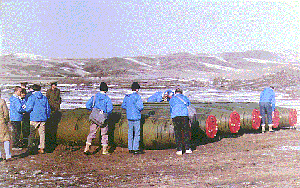| First American Inspections | ||
 The first American inspectors under the INF Treaty began their flight to the Mosow point of entry from Frankfurt, West Germany. General Lajoie, with the members of the first teams standing on the runway, speaks to the press. July 1,1988. |
On July 1,
1988, exactly 30 days after Reagan and Gorbachev had
exchanged the instruments of ratification, American and
Soviet inspection teams boarded aircraft and flew to
designated points of entry to begin the INF Treaty's
first baseline inspections. The treaty specified that
each nation could have only 200 INF inspectors on an
approved list at any one time. Two other lists contained
the names of 200 INF portal monitoring inspectors and 200
aircrew members. These lists had to be exchanged "no
later than one day after entry into force of the
Treaty."6 The treaty further specified that each inspection team could have no more than 10 members. To carry out the U.S. baseline inspections, OSIA had selected, organized, and trained 20 inspection teams. In late June, eight of these teams flew from Washington to the agency's gateway field office in Frankfurt, while another four teams went to Yokota Air Base, the site of the agency's gateway field office in Japan.7 The remaining teams would be deployed later during the 60-day baseline period. General Lajoie was a member of the first American team to conduct an INF on-site inspection in the Soviet Union.8 Led by Lt. Colonel Lawrence G. Kelley, USMC, the team consisted of the team chief, deputy, linguists, missile operations specialists, and other specialists skilled in specific areas of operations. In the weeks leading up to the initial baseline inspections, General Lajoie remembers speaking to team chiefs, field office escort officers, linguists, noncommissioned officers, team members, and headquarters staff. "I gave a lot of briefings and I tried to establish a tone, [but] I had trouble finding the words." He stressed that American inspectors and escorts had to be professional and businesslike. "They represented the U.S. government; I wanted them to be polite, but I wanted them to be firm and follow their plan."9 Lajoie emphasized that the on-site inspection mission was not a clash between two conflicting world systems; rather, it was a limited, specific job, carefully defined within a single treaty. |
